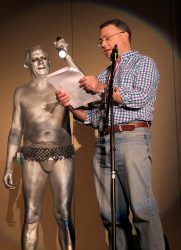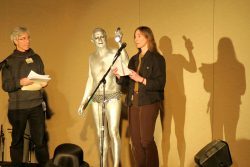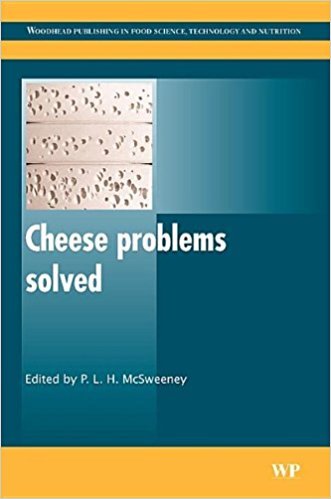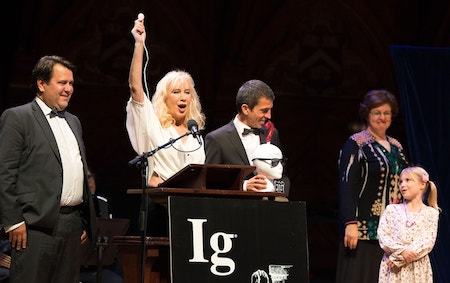Marc Abrahams's Blog, page 202
December 3, 2017
Monday afternoon in Heidelberg
Join us Monday afternoon at the European Molecular Biology Laboratory (EMBL) in Heidelberg, for a talk about improbable research and the Ig Nobel Prizes.
It begins at 3:00 pm. Hecklers are, as always, welcome. Here are details.

December 1, 2017
McSweeney’s ‘Cheese Problems Solved’
Anyone with cheese problems might consider reading the book Cheese Problems Solved, edited by Paul L.H. McSweeney, published by Elsevier in 2007. McSweeney is a Professor of Food Chemistry in the Department of Food and Nutritional Sciences, University College, Cork, Ireland.
Readers of cheese detective stories might especially relish the report “How May the ‘Toad-Skin’ and Cat-Hair’ Defects of Camembert Cheese Be Solved?” by H.E. Spinnler and M. N. Leclercq-Perlat, on pages 280-281.
BONUS: “The importance of smelly feet and stinky cheese” [BMJ]

November 30, 2017
Readers needed for the Ig Nobel event at Arisia

Calling all Arisia fen: Improbable Research will return to Arisia on Friday night, January 12, 2018 and we’re asking the fen to nominate people to read from some research papers (that we will supply) on stage.
What qualities should the person you nominate have to be a reader at this event:
Charismatic stage presence
Good speaking voice
Able to read clearly and vivaciously into a microphone
Not easily rattled when asked strange questions about a strange research paper they themselves have only just skimmed
Attending Arisia on Friday Jan 12, 2018
This event will feature brief, dramatic readings from studies and patents that have won an Ig Nobel prize. Shortly before this event begins, we will supply our Readers with a selection of papers and patents to choose between.

(photo by D. Kessler)
They choose one, and then find the portions of it they want to read – or present in some other dramatic manner – to the audience.
Each presentation will be 2 minutes long, after which the Reader may (if they wish) entertain questions from the audience. In answering these questions, they may draw from the paper or from their personal experience. They may surmise or deflect, but they must not lie.
NOMINATIONS
If you know someone who should read at this event, then please email us about them (details on the nomination page.
If you would like to know people like this, then head to our nomination page and see who has already been nominated.
We encourage you to nominate convention Attendees, Staff, Vendors, or Other Unexpected People who would do a good job (see the list of qualities, above).

Do you know someone who should be illuminated by The Human Spotlight? (photo by D. Kessler)

Urinary relief hatch for waders (new patent)
One of the problems with waterproof waders and foul weather gear is that they tend to be waterproof in both directions. A newly patented invention from Robert A. Stevenson and Wendy L. Stevenson of Canyon Country, California finds a way through this logical quandary with a specially developed hatch.
The invention can be described (in part) by the following 297 word sentence :
“An exemplary embodiment of the present invention includes a waterproof pair of pants and/or waders including a sealable opening for relief of bodily fluids, comprising: a pair of pants and/or waders comprising a first and a second leg portion, wherein the first and the second leg portions are joined to a torso portion terminating generally at or between a waist and a neck of a wearer, wherein the pair of pants and/or waders comprise a substantially waterproof material; a rigid frame sealed in a waterproof manner to the pair of pants and/or waders disposed in a groin section of the pair of pants and/or waders, wherein the frame forms a frame aperture separating an outside of the pair of pants and/or waders from an inside of the pair of pants and/or waders; a rigid lid pivotably or movably connected to the frame disposed on the outside of the pair of pants and/or waders and configured to engage the frame aperture; a seal disposed between the frame and the lid forming a waterproof closure of the frame aperture when the lid is in a closed position; a rigid backing forming a backing aperture, wherein a first surface of the backing and a back side surface of the frame capture there between the waterproof material of the pair of pants and/or waders in the groin section; at least one adhesive bond disposed between the back side surface of the frame and the waterproof material of the pair of pants and/or waders, and/or, between the first surface of the backing and the waterproof material of the pair of pants and/or waders; wherein the backing aperture and frame aperture are substantially aligned; and wherein the backing aperture is equal to or greater in surface area in comparison to the frame aperture. “
The hatches are available in a number of different formats, which may be suitable for both male and female wader wearers. For full details, see: US patent 9808037, November 7th 2017.

November 27, 2017
The ‘Singing Cymbal’ controversy
The photo above is a still from a CERN teaching resources video (2014).
“Use a cymbal or metallic plate that can vibrate freely. Use a flash, for example from a camera, hold it close to the plate and flash. You will hear a low tone.
Physics: The moment of the photons are transferred in an inelastic collision to the atoms of the cymbal. This can also be used as an example of energy conversion.”
Not so fast, say Thomas R Moore, Samantha Collin and Nikki Etchnique of the Department of Physics at Rollins College in their paper ‘The singing cymbal : Is it really photon momentum?’
“Although it has been generally accepted that this is a demonstration of the effects of photon momentum, and the idea promulgated by a world-class institution such as CERN, this does not necessarily make it so.”
Their experimental and theoretical study found that the cymbal does indeed ‘sing’ – but primarily from heating and acoustic effects caused by the camera flash. Only a tiny fraction of the vibration, they say, is due to photon momentum transfer effects – equivalent to dropping just one grain of salt onto the cymbal (with inaudible results).
NOTE: Unfortunately, CERN’s ‘Singing Cymbal’ experiment is now off-line – but an archive from 2014 is available here. The video itself is available in a somewhat obsolete format (.rm) here.

November 24, 2017
TODAY —Ig Nobel on “Science Friday”
Today is the annual special Ig Nobel Prize Ceremony broadcast on the Science Friday program on public radio in the US (and on the Internet).
It’s a specially edited recording of the 27th First Annual Ig Nobel Prize ceremony. Give it a listen!

November 23, 2017
“Junk”—a new play about the first Ig Nobel Economics Prize winner (Michael Milken)
“Junk” is a new play, based on the life of the winner of the first Ig Nobel Economics Prize.
That Ig Nobel prize was awarded, in 1991, to Michael Milken, titan of Wall Street and father of the junk bond, to whom the world is indebted.
 James B. Stewart reviewed the new play, for the New York Times, under the headline ” ‘Junk’ Mines the Milken Era for Truths That Resonate Now.” Stewart writes:
James B. Stewart reviewed the new play, for the New York Times, under the headline ” ‘Junk’ Mines the Milken Era for Truths That Resonate Now.” Stewart writes:
But make no mistake about it: “Junk” is about as close to reality as theater gets.
I should know: I’m the author of “Den of Thieves,” which chronicled the rise and fall of Michael Milken and his junk bond empire and the cast of characters that whirled around him. The author of “Junk,” Ayad Akhtar, has cited my book and “The Predators’ Ball,” Connie Bruck’s pathbreaking account of Mr. Milken’s heyday at Drexel Burnham Lambert, as works that influenced his play.

Burgeoning British appreciation of pseudo-profound bullshit
A new book—Business Bullshit, by André Spicer—follows in the tradition of the study that won the 2016 Ig Nobel Peace Prize.
That Ig Nobel Prize was awarded to Gordon Pennycook, James Allan Cheyne, Nathaniel Barr, Derek Koehler, and Jonathan Fugelsang for their scholarly study called “On the Reception and Detection of Pseudo-Profound Bullshit.” They published that study in the research journal Judgment and Decision Making (vol. 10, no. 6, November 2015, pp. 549–563).
André Spicer is a Professor of Organizational Behaviour at Cass Business School, City University London. Some of his Business Bullshit is reprinted in today’s issue of The Guardian newspaper.
BONUS: Spicer’s professorial colleague, David Sims, was awarded the 2008 Ig Nobel Literature Prize, for Sims’s study called “You Bastard: A Narrative Exploration of the Experience of Indignation within Organizations, That study was published in the research journal Organization Studies (vol. 26, no. 11, 2005, pp. 1625-40).

Appreciating the Ig Nobel Prize-winning momma-to-baby vaginal music communicator
The inventors of Babypod, the insert-into-your-vagina device that helps a pregnant woman play music for her developing fetus, produced this video ad:
The 2017 Ig Nobel Prize for Obstetrics was awarded to those physician/inventors—Marisa López-Teijón, Álex García-Faura, Alberto Prats-Galino, and Luis Pallarés Aniorte—for showing that a developing human fetus responds more strongly to music that is played electromechanically inside the mother’s vagina than to music that is played electromechanically on the mother’s belly.
Here’s video of the team at the Ig Nobel Prize ceremony at Harvard University, and the Ig Informal Lectures at MIT:
They describe their research in the study: “Fetal Facial Expression in Response to Intravaginal Music Emission,” Marisa López-Teijón, Álex García-Faura, and Alberto Prats-Galino, Ultrasound, November 2015, vol. 23, no. 4, pp. 216–223.
Their product, called “Babypod,” is covered by the patent “Fetal Acoustic Stimulation Device,” patent ES2546919B1, granted September 29, 2015 to Luis y Pallarés Aniorte and Maria Luisa López-Teijón Pérez.
Babypod has enjoyed a fair amount of attention. This video celebrates some of that:

November 22, 2017
The nature and structure of crumpets [research studies]
Remarkably, given the extensive scientific literature on bread-making, there is very little recorded research on crumpet-making. If you’re not familiar with the crumpet, here is an introduction from one of the few formal crumpet studies, performed by Professor Pyle of Reading University, UK, c. 2005.
“Crumpets are, it seems, a particularly British product. They are made from a dilute fermented batter which is baked rapidly (in around 3 min) on a hot plate, typically at 200–230 °C. Their structure is intriguing with its characteristic predominantly vertical columnar porous structure, not unlike some volcanic vesicular pumices or controlled porosity metal foams (Shridar et al. 1995). This structure is also essential to eating quality, with its capacity to soak up melted butter or soft cheese.”
 The experimental study, which X-rayed crumpets at various stages of cooking, showed, for the first time that :
The experimental study, which X-rayed crumpets at various stages of cooking, showed, for the first time that :
“ […] whilst the voidage fraction remains approximately constant, there is a significant increase in the mean diameter of the vertical pores over the crumpet height. Bubble nuclei and the release of carbon dioxide from the heated batter are crucial for pore development. Surprisingly, the internal structure develops very rapidly although it needs 3–4 min to completely form the porous structure.
See: Crumpet Structures: Experimental and Modelling Studies Trans IChemE, Part C, Food and Bioproducts Processing, 2005, 83(C2): 81–88.
Further reading : Mathematical Modelling of Crumpet Formation by Peter Sadd, Page 403, Chapter 38, ‘Bubbles in Food 2, Novelty Health and Luxury’ 2008

Marc Abrahams's Blog
- Marc Abrahams's profile
- 14 followers










